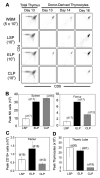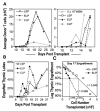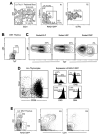Primitive lymphoid progenitors in bone marrow with T lineage reconstituting potential
- PMID: 16920923
- PMCID: PMC1850233
- DOI: 10.4049/jimmunol.177.5.2880
Primitive lymphoid progenitors in bone marrow with T lineage reconstituting potential
Abstract
Multiple subsets of the bone marrow contain T cell precursors, but it remains unclear which is most likely to replenish the adult thymus. Therefore, RAG-1+ early lymphoid progenitors (RAG-1+ ELP), and CD62L/L-selectin+ progenitors (LSP), as well as common lymphoid progenitors from C57BL6-Thy1.1-RAG-1/GFP mouse bone marrow were directly compared in transplantation assays. The two c-Kit(high) populations vigorously regenerated the thymus and were superior to common lymphoid progenitors in magnitude and frequency of thymic reconstitution. Regeneration was much faster than the 22 days described for transplanted stem cells, and RAG-1+ ELP produced small numbers of lymphocytes within 13 days. As previously reported, LSP were biased to a T cell fate, but this was not the case for RAG-1+ ELP. Although RAG-1+ ELP and LSP had reduced myeloid potential, they were both effective progenitors for T lymphocytes and NK cells. The LSP subset overlapped with and included most RAG-1+ ELP and many RAG-1- TdT+ ELP. LSP and RAG-1+ ELP were both present in the peripheral circulation, but RAG-1+ ELP had no exact counterpart among immature thymocytes. The most primitive of thymocytes were similar to Lin- c-Kit(high) L-selectin+ TdT+ RAG-1- progenitors present in the marrow, suggesting that this population is normally important for sustaining the adult thymus.
Figures






References
-
- Scollay R, Smith J, Stauffer V. Dynamics of early T cells: prothymocyte migration and proliferation in the adult mouse thymus. Immunol Rev. 1986;91:129–157. - PubMed
-
- Bhandoola A, Sambandam A. From stem cell to T cell: one route or many? Nat Rev Immunol. 2006;6:117–126. - PubMed
-
- Balciunaite G, Ceredig R, Fehling HJ, Zúñiga-Pflücker JC, Rolink AG. The role of Notch and IL-7 signaling in early thymocyte proliferation and differentiation. Eur J Immunol. 2005;35:1292–1300. - PubMed
Publication types
MeSH terms
Substances
Grants and funding
LinkOut - more resources
Full Text Sources
Medical
Research Materials
Miscellaneous

